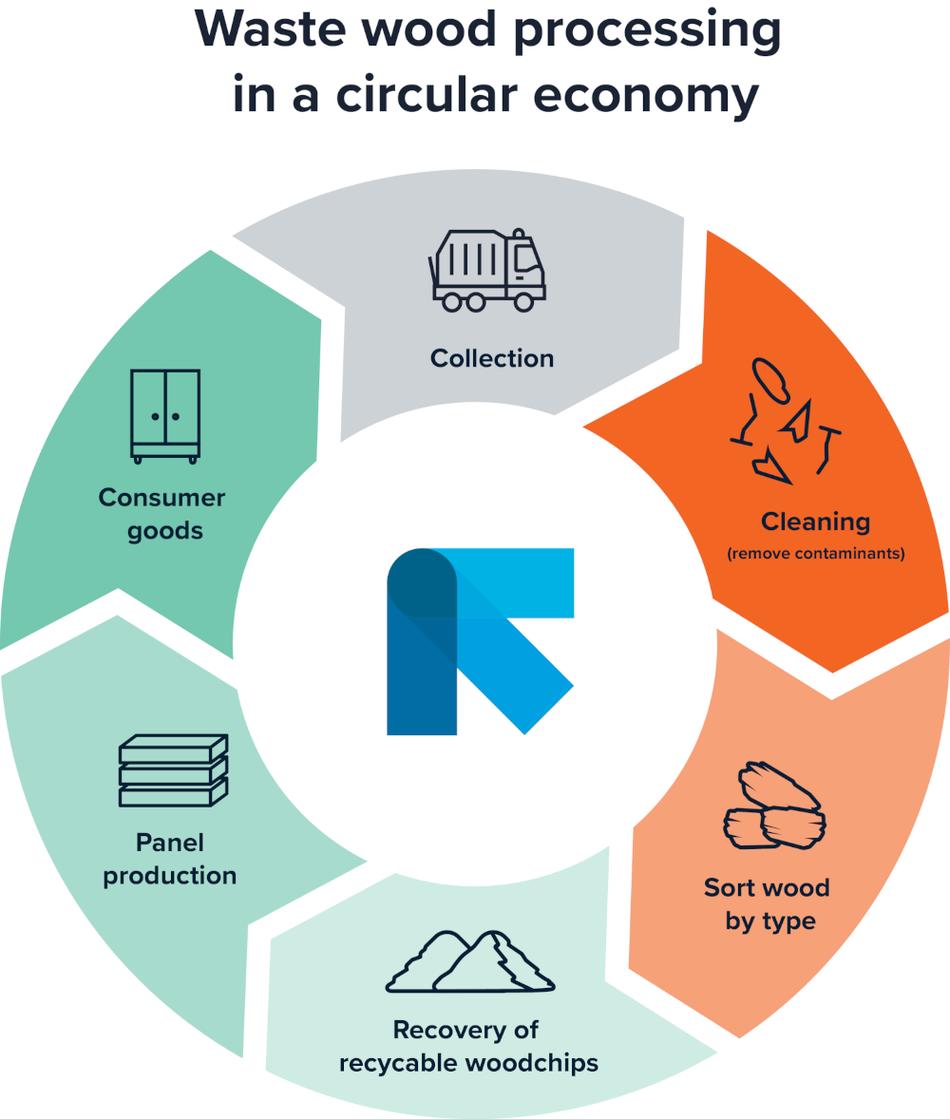From wood to resource market update in times of challenges

In only a couple of months, two developments are significantly influencing the status quo of the sector. On the one hand, there is no place in the world where the impacts of climate change haven’t become evident. Whether it is extreme heat, large-scale floods, or wildfires, climate change is quickening its pace. On the other hand, energy prices in Europe are on the rise and the cold winter months ahead could lead to sky-high power bills. In this article, we will have a look at how both the energy crisis in Europe and the weather extremes impact the wood industry and how a transition to a circular economy can help overcome these challenges.
European energy crisis
The current energy crisis, with gas prices being at record heights, has a major impact on the wood sector. Households now tend to turn to conventional heating methods such as wood-burning stoves. In Germany, for instance, where 50% of all homes are heated with gas, people started to stockpile wood for fear of gas shortages.1
For centuries, wood has been a reliable and affordable source of energy. To date, 50 million homes in Europe use energy recovered from biomass.2 With the aim to create sustainable energy systems and limit resource scarcity, renewable energy sources like biomass will only continue to grow.3
Climate change
It has been decades since we heard about the urgency to combat climate change and only little has happened to mitigate its effects. This year, maybe more than ever before, we are experiencing the devastating aftermaths of climate change. Extreme weather has significantly impacted forests and thereby the condition and availability of wood. Canada, which covers about one quarter of the wood demand in the US, is suffering from severe drought and wildfires that are disrupting the supply chain.4 At the same time, drought leads to insect infestations that considerably affect the condition of wood and thereby potentially the quality of the wood-based products.
A variety of industrial and consumer products consist of wood and the furniture industry is producing wood-based panels on a large scale to meet the growing consumer demands. Unfortunately, wood has turned into a product that no longer grows on trees since its demand has long exceeded the volume Earth can naturally provide.5
The ceaseless lack of supply has only recently been further exacerbated by the climate emergency and the European energy crisis as well as the ongoing war between Russia and Ukraine. With the start of the war, the European Union decided to stop imports including wood and wood-based products from both Russia and Belarus. This entails a gap of approximately 4.5 cubic meters of swan lumber annually.6 As a consequence, the wood-based panel industry is exposed to severe challenges in sourcing enough raw material that is still suitable to be processed to superior quality products.

Pricing trends
Current lumber prices are an eye-opening reflection of the scope of the sector’s challenges. In Bulgaria, for instance, where the use of wood-burning stoves is common, firewood prices have doubled, reaching up to 150€/cubic meter.7 In Germany, prices for wood and pellets have multiplied by 2.5 and pellet production plants can hardly keep pace in producing enough saleable material.8 In the US lumber prices outperformed those of gold and bitcoins and wood is expected to become the most desirable commodity.9
The price for non-processed wood chips for instance shot up by 450% within the last year. In 2021, collectors had to pay for disposing of hazardous waste wood but today some licensed facilities are even rewarding waste collectors for the material. Given the recent challenges, prices are predicted to increase even more mid-to-long term.
Such dynamic trends can be turned into opportunities
and incentivizes us to change the way we treat and manage our resources.
Recycling enables access to material
When energy-intense primary production is hampered by material shortage and unprecedented prices, manufacturers must find ways to access materials to secure profits. An environmentally friendly and economically viable solution is the reuse of recyclable materials. Until recently, most wood has been downcycled rather than being turned into recycled content that features virgin-like qualities and is applicable for the manufacture of higher grade applications.10 If we kept wood-based panels in a closed loop, we could bridge the gap between supply and demand and contribute to meeting sustainability targets.

Actually, wood is a circular material and trees a best-practice example of renewability: it all starts with a small seed that is planted and nurtured by nutrients found in the soil, and the tree starts growing. During the tree’s lifecycle, it uses nutrients from the soil to produce oxygen with its leaves. In fall, the leaves fall, are absorbed by the soil, and provide nutrients for the next generation of trees. As the example shows us, trees are circular by nature from the beginning to their end of life. Given the recent developments and the industry’s aim to make its processes more sustainable, it is time to also apply the concept of circularity to the end-of-life cycle of trees.
Enabling a circular economy for wood
To date, huge volumes of wood end up in landfill instead of being recycled and processed into new products. Stepping away from linear production and consumption toward a circular model would enable the industry to alleviate supply shortages and prices and save valuable resources.
To get there, we must introduce a holistic approach that includes the collection, sorting, and recycling of waste wood. While the necessary infrastructure is still in its infancy in many countries throughout the world, market trends signal that investing in waste wood recycling can be economically advantageous.
Apart from the economic advantages, a circular economy for wood is a promising concept to reduce CO2 emissions. Production with recycled wood emits less CO2 than processes with primary materials. For example, one cubic meter of ready-to-market particleboard absorbs 720kg CO2 and MDF even 820kg .11
Technological advancements
A circular economy that exploits the full potential of natural resources like wood depend on the advanced cleaning, sorting and recycling of waste wood. Whereas traditional cleaning methods, such as magnets, air and water separators, deliver adequate results for smaller plants that do not require high throughput and purity levels, manufacturers looking to increase recycled content require the most advanced sorting technology. A combination of X-Ray sorting units to remove inert materials from waste wood and optical sensor-based sorters further purification enables plant operators to unleash new opportunities. First, they can run high throughputs and reach new purity levels. Second, they can create new revenue streams when upgrading the optical sorter with deep learning technology. Sorting software based on deep learning allows for the detection, analysis and separation of different wood grades and can even recover medium-density fiberboard (MDF) from a processed waste wood stream.
What’s next
In recent years, the industry has undergone considerable change and made huge progress related to sustainability. Infrastructures to collect, sort, and recycle waste wood have been put in place in countries and regions that have recognized the untapped potential of waste wood. With the market introduction of smart sorting technologies that outperform many conventional methods, recycling has become a promising concept for both the industry and nature. In the future, the wood-based panel industry will increasingly turn to recycled wood to access materials, develop products of higher quality, reduce costs and dependence on material availability, and realize higher yields.
Once holistic approaches are widely established, we must go beyond closing the loop on particleboards and address circularity for all types of wood-based materials some of which are currently still difficult or impossible to recycle. In general, the solution is quite simple: the more wood is kept in use, the more we protect our planet and minimize deforestation, a factor that is propelling climate change. There is still a long way to go, and the imbalance of supply and demand will not disappear overnight, but we’ll get there if we join forces and remind ourselves of the necessity to maximize resource use and recovery. Don’t forget, wood is good, recycled wood is better.
Sources:
1 https://www.dw.com/en/germany-stockpiling-wood-in-fear-of-gas-shortage/a-62601419
2 https://unherd.com/thepost/firewood-the-premodern-solution-to-britains-energy-crisis/
3 https://www.renewableenergymagazine.com/biomass/biomass-market-growth-promoted-by-increasing-investments-20220627#:~:text=The%20biomass%20electricity%20market%20size
4 https://www.cnbc.com/2021/08/19/climate-change-supply-chain-disruptions-how-to-prepare.html
5 https://community.materialtrader.com/cascading-wood-towards-the-circular-economy/
6 https://www.metsagroup.com/metsafibre/news-and-publications/news-and-releases/stories/2022/price-of-sawn-timber-settling-at-a-new-normal/
7 https://www.euractiv.com/section/energy-environment/news/firewood-prices-shortages-spell-cold-winter-for-europes-poorest/
8 https://www.dw.com/en/germany-stockpiling-wood-in-fear-of-gas-shortage/a-62601419
9 https://www.theatlantic.com/science/archive/2022/01/why-climate-change-pushing-lumber-prices/621288/
10 https://community.materialtrader.com/cascading-wood-towards-the-circular-economy/
11 https://www.researchgate.net/publication/320375411_Carbon_storage_in_wood_products#pf5
